Maragheh observatory
Maragheh observatory (Persian: رصدخانه مراغه) was an astronomical observatory established in 1259 CE under the patronage of the Ilkhanid Hulagu and the directorship of Nasir al-Din al-Tusi, a Persian scientist and astronomer. Located in the heights west of Maragheh, which is today situated in the East Azerbaijan Province of Iran, it was once considered "the most advanced scientific institution in the Eurasian world".[1]
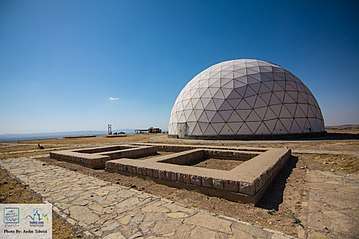
It was financed by waqf revenues, which allowed it to continue to operate even after the death of its founder, and was active for more than 50 years. It served as a model for later observatories including the 15th-century Ulugh Beg Observatory in Samarkand, the 16th-century Taqi al-Din observatory in Constantinople, and the 18th-century Jai Singh observatory in Jaipur.[2]
Description
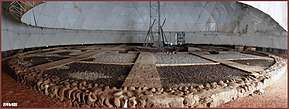
There were multiple buildings constructed at the observatory site including a main building and five circular buildings containing observational instruments for astronomical research.[3] Living quarters were also present on the site as well as a building for metalworking.[3] There was also a 330 m2 building that was used as the library.[3] It is said that at one time the library held over 400,000 volumes of literature related to astronomy and astrology.[4]
The main building is circular with a diameter of 22 m.[4] The entrance was 1.5 m wide and opened to a hallway that was 3.1 m wide that marked the meridian line.[4] There were six rooms on either side of the hallway.[3] These structures were made of mainly clay, brick, and mud.[4] The final structure at the observatory was a tower.[4] In a 340 × 135 m citadel-like area stood a four-story circular stone building with a diameter of 28 m.[4]
The mural quadrant to observe the positions of the stars and planets was aligned with the meridian. This meridian served as the prime meridian for the tables in the Zij-i Ilkhani. In total the observatory spans an area of 150 m by 350 m.[5] Today, considerable parts of the groundwork from these structures are preserved in the ruins.
History

The construction of the observatory began in 1259.[6] This is according to multiple books including Jam-e-ttavarikhe rashidi (Persian: جامع التواريخ رشيدي), saf-e-elhofreh (Persian: صاف الحفره), and favat-o-lvafiyyat (Persian: فوات الوفيات) [7] The observatory came to be because of Nasir al-Din al-Tusi, a Persian mathematician, astronomer and philosopher.[3] He acted as an advisor to Hulagu, a grandchild of Genghis Khan.[3] Tusi complained to Hulagu that his astronomical tables had to be adapted to the latitude and longitude of Hulagu's new capital.[8] Hulagu gave Tusi permission to build a new observatory in the location of his choosing, and Tusi chose Maragha, Iran, where he became the director of the observatory.[3] Men of mathematics, science, and astronomy came to the Maragheh Observatory from across the Islamic world and further. According to historical texts recovered from the observatory, the site had a reputation so widespread it had reached as far as China as students had traveled to study mathematics, physics, and astronomy.[4] Other scholars in attendance included Bar-Hebraeus, who late in his life took residence close to the observatory in order to use the library for his studies. He has left a description of the observatory.
A number of other prominent astronomers worked with Tusi at the observatory, such as Muhyi al-Din al-Maghribi, Mu'ayyid al-Din al-'Urdi, from Damascus, Qutb al-Din al-Shirazi, and Hulagu's Chinese astronomer Fao Munji, whose Chinese astronomical experience brought improvements to the Ptolemaic system used by Tusi.
After 12 years of intense work by Tusi and other scientists, including Mu’yed al-Din al-Arad-Najmedin Cathy, Najmd al-Din Qazvini, Allame Qutbuddin Shirazi, and Fakhruddin Maraghi, the tables were compiled in the Zij-i Ilkhani.[4] The tables were published during the reign of Abaqa Khan, Hulagu's son, and were named after the patron of the observatory.
The downturn of the Maragheh Observatory began in the 13th century.[3] After the death of Tusi in 1274 his son took over as director.[3] However, with the death of Hulagu in 1265 and his son Abaqa in 1282, the observatory no longer had patrons to fund the research being conducted.[3] The observatory became inactive by the beginning of the 14th century.[3] Over time the site turned to ruins as a result of frequent earthquakes and a lack of funding by the state to preserve the site. Shah Abbas the Great arranged for repair; however, this was not commenced due to the king's early death.
During the Mongol invasions and conquests in this region, the contents of the observatory's library were stolen.[5]
The remains inspired Ulugh Beg to construct his observatory in Samarkand in 1428.
Hulagu's older brother, Khublai Khan, also constructed an observatory, the Gaocheng Astronomical Observatory in China.
A celestial globe from the observatory made around 1279 is now preserved in Dresden, Germany. It is a rare example of decorative art from Iran of the 13th century, designed by al-Urdi and made of bronze inlaid with silver and gold.
Current status
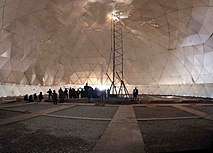
After 1978, Tabriz University, which is located near the observatory, was placed in charge of its preservation.[9] Today the site is home to occasional star parties and, though there are no official tours offered, the public is still welcome to come and see the remains of the observatory.[3]
The observatory is currently covered with a brass dome and is situated two miles west of Maragheh. To save the installation from further destruction, the Cultural Heritage Organization of Iran built a dome-framed shelter and it plans to hold an exhibit of astronomical devices used at Maragheh Observatory.
Hulagu Khan
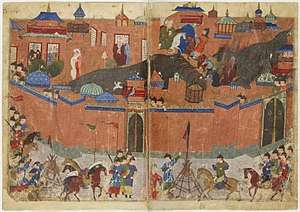
Hulagu Khan was a Mongol ruler and the grandson of Genghis Khan. As the Mongols expanded their territory Hulagu was put it charge of conquering Mesopotamia, Persia, Egypt, Syria, and the Abbasid Caliphate.[10] From 1253 to 1256, Hulagu and his army were fighting to take control of the region of Iran known as Alamut.[10] It was in 1256 that Hulagu took down the Castle of Alamut.[10] Here he met al-Tusi.[10] Many of the scholars of the region had fled to the mountains for sanctuaries to continue their studies as Tusi had in this castle.[10] However, there is dispute over whether or not Tusi was there against his will, or even somehow helped the Mongols get in and attack.[11]
Tusi was respected by Hulagu for his scholarship in science and decided to make him an advisor.[12] Hulagu and his men, along with Tusi, then went to Baghdad where the city was laid to waste.[12] Hulagu later made Tusi a wazir, or a high ranking advisor or official.[13] He also placed him in charge of waqfs, or religious endowments.[13] Given his trust in Tusi and his respect for the sciences and astronomy, it is not surprising that Hulagu supplied the funding for the Maragheh Observatory when Tusi complained of needing new astronomy tables.[14] He even made Maragheh the capital of his empire.[14]
Astronomers who worked at the observatory
Nasir al-Din al-Tusi
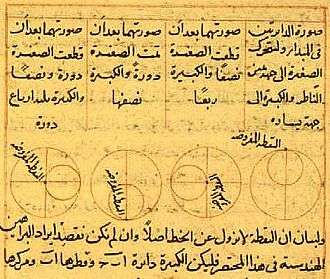
Nasir Al-Din al-Tusi's most notable work was the creation of the Tusi-couple, a geometry based system that solved some of the fundamental issues with the Ptolemaic system's description of planetary motion.[15] The Tusi-couple uses two different sized circles with the smaller of the two placed with its center tangent to the larger circle.[15] When a point is placed on the smaller sphere and both are set into motion, both rotating at different speeds with the smaller circle's center rotating with the larger circle, the point looks as if it was oscillating about a line.[15] Some other notable works Tusi conducted were commentaries and revisions of Euclid's Elements and Ptolemy's Almagest as well as the astronomical handbook titled Zīj-i Īlkhānī detailing the movement of the planets, of which he was the lead author.[15]
Muhyi al-Dīn al-Maghribī
Muhyi al-Dīn al-Maghribī was an astronomer who worked with Tusi at the observatory.[16] His contributions in astronomy while working at the observatory are three comments in the Almagest relating the creation of an astrolabe, the determining of the meridian line and revolution of a sphere, and work on the Chinese and Uighur calendars.[16] Also while working at the observatory he wrote Khulāṣat al‐Majisṭī, which translates to Summary of the Almagest.[16]
Mu'ayyid al-Din al-'Urdi

Mu'ayyid al-Din al-'Urdi was an astronomer and engineer who was asked by Tusi to come to Marāgha and help design and construct the observatory.[17] He played a key part in the building of the observatory by producing large water wheels to bring water towards the hill where the observatory would be.[17] Al-'Urdi was noted as one of the instrument makers in the observatory and he wrote the treatise ‘Urḍī's Risāla fī Kayfiyyat al‐arṣād, which is preserved in a manuscript in Paris, and details the instruments in the observatory that were constructed before 1262 AD.[17] Some notable instruments documented in this treatise include the Mural quadrant, an armillary sphere which was used to measure the ecliptic longitude and latitude, a solstitial armilla which was used to determine the obliquity of the ecliptic, and an equinoctial armilla which was used to determine when the sun entered the equatorial plane as well as the path of the sun.[17]
Notes
- Blake, Stephen P. (2016). "The observatory in Maragha". Astronomy and Astrology in the Islamic World. Edinburgh University Press. p. 65. ISBN 978-0748649112.
In the history of Islamic astronomy the thirteenth century was the most important. It witnessed the founding of the Maragha Observatory, the most advanced scientific institution in the Eurasian world.
- Dallal, Ahmad (2010). Islam, science, and the challenge of history. Yale University Press. pp. 24–25. ISBN 9780300159110.
- "UNESCO Astronomy and World Heritage Webportal – Show entity". www3.astronomicalheritage.net. Retrieved 2019-03-16.
- "بهنام". www.ichodoc.ir. Retrieved 2019-03-16.
- "Maragheh Observatory". www.iranreview.org. Retrieved 2019-03-17.
- "UNESCO Astronomy and World Heritage Webportal – Show entity". www3.astronomicalheritage.net. Retrieved 2019-03-08.
- Citation error. See inline comment how to fix.
- Citation error. See inline comment how to fix.
- "UNESCO Astronomy and World Heritage Webportal – Show entity". www3.astronomicalheritage.net. Retrieved 2019-03-08.
- "بهنام". www.ichodoc.ir. Retrieved 2019-03-20.
- "The Maragha Observatory Complex in Ilkhanid Iran | MPIWG". www.mpiwg-berlin.mpg.de. Retrieved 2019-03-20.
- "Hulagu Khan Destroyed Thousands Of Priceless Ancient Books Kept In The House Of Wisdom In Baghdad | Ancient Pages". www.ancientpages.com. Retrieved 2019-03-20.
- "Nasir al-Din al-Tusi and Astronomy | The Institute of Ismaili Studies". iis.ac.uk. Retrieved 2019-03-20.
- "Nasir al-Din al-Tusi (1201–1274)". www-history.mcs.st-andrews.ac.uk. Retrieved 2019-03-20.
- "Nasir al-Din al-Tusi | Muslim Heritage". muslimheritage.com. Retrieved 2019-04-12.
- "Ibn Abi al-Shukr". islamsci.mcgill.ca. Retrieved 2019-03-16.
- "Urdi". islamsci.mcgill.ca. Retrieved 2019-03-16.
References
- A. Baker and L. Chapter (2002), "Part 4: The Sciences". In M. M. Sharif, "A History of Muslim Philosophy", Philosophia Islamica.
- Richard Covington (May–June 2007). "Rediscovering Arabic science", Saudi Aramco World, p. 2–16.
- Ahmad Dallal, "Science, Medicine and Technology.", in The Oxford History of Islam, ed. John Esposito, New York: Oxford University Press, (1999).
- Morelon, Régis; Rashed, Roshdi (1996), Encyclopedia of the History of Arabic Science, 3, Routledge, ISBN 0-415-12410-7
- George Saliba (1999). Whose Science is Arabic Science in Renaissance Europe? Columbia University.
External links
- Maragheh observatory at Iranian Cultural Heritage Organization Documentation Center
- Research Institute for Astronomy and Astrophysics of Maragha
- On Maragheh observatory at RIAAM
- Contribution by Parviz Tarikhi with illustrations
- Copy of the celestial globe
- Al-Urdi's Article on 'The Quality of Observation', FSTC Limited
- Tishineh
